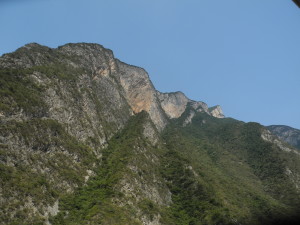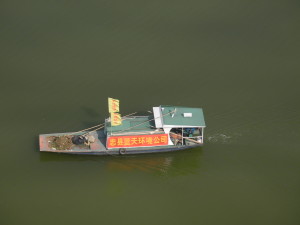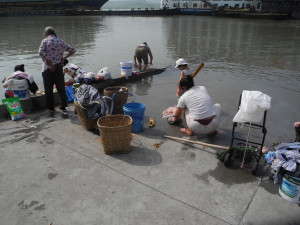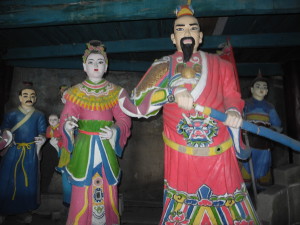Fifth in a Series:
The Three Gorges Dam along China’s Yangtze is a marvel of engineering — it’s the world’s largest power station ranked by energy generation, providing hydroelectric power for millions of people — and a disaster for the 1.4 million Chinese who had to be relocated when the dam flooded the Yangtze in the late 1990’s and early 2000’s.
Some 1,500 villages, towns and cities were flooded and now lie beneath or partially beneath the river, as the water levels rose some 300 feet along the scenic Three Gorges, where steep mountains line both sides of the Yangtze.
Most former residents, many of them farmers, have been relocated to cities like Chongqing — which now has a startling population of 33 million — or to special “relocation cities,” where the river dwellers have been moved into new apartment buildings that stand higher than the new water level.
In addition, well over 1,000 archaeological sites were flooded; some cultural treasures were rescued and moved, others lost forever.
The extent of environmental damage won’t be known for years, but over-silting, earthquakes, and loss of plant and animal life are all likely byproducts. Various species of dolphins, porpoises and alligators are gone or endangered.
All this information — freely presented by lectures aboard the Victoria Katarina, the Victoria Cruises river ship that my wife, Catharine, and I recently took up the Yangtze — gives something of a surreal quality to the cruise.
As you sail through magnificent scenery, with still-towering mountains standing watch over the famous Three Gorges, you can’t help but realize you’re crossing over what was once a thriving residential and agricultural area, occupied by well over a million people who have now lost their ancestral homes.
But the Three Gorges Dam, a dream of Chinese leaders since the days of Sun Yat-Sen in the 1920s and finally completed only in the past few years, is a done deal, and the Chinese — at least those who weren’t relocated — seem proud of it.
As the local guide who led our tour of the dam on the first full day of the cruise put it, “Only one country in the world — China — could complete a project of this size and cost so quickly.” (She added that her grandmother was one of those who lost her home to the flooding — “But it worked out OK, because now she lives with us.”)
And it’s true — the Chinese government, after all, can do what it wants without opposition, uprooting residents and risking environmental damage as necessary for the greater good: i.e., power for the people.
The Three Gorges
We viewed some of the first scenic gorge, Xiling, through the window next to our table at lunch on the first day of the cruise. Victoria Cruises had generously provided Catharine and me with a table for two with a view in the “Top of the Yangtze” dining room, available with the “Executive” package that normally costs extra, and comes with some other perks as well.
Located on the top (sixth) deck of the ship, the Top of the Yangtze was a step above the Dynasty dining room several decks below, where most of the tables sit six or eight, perfect for the tour groups that most passengers were with.
The Top of the Yangtze featured a nice buffet breakfast and lunch, and an a la carte menu at dinner, served at the table. The servers were delightful, and wine or beer was complimentary.
The buffets included a mix of Chinese and Western dishes; we pretty much stuck to the Chinese, enjoying such things as congee (rice porridge) with pickled vegetables for breakfast and a variety of delicious vegetables for lunch. The dinners tended to be more Western, but often with Asian or other ethnic touches. One outstanding one was Moroccan-style lamb chops; seafood was also prominent.
The Xiling, which starts at our embarkation city of Yichang, is 60 miles long, and we took it slowly. It used to be known as a very dangerous gorge, with strong current and rocks – thought to be the gateway to hell because so many were killed on it. Boats could only pass in daytime. Now the current is controlled, the rocks have been removed, and the passage is safe.
On the second morning, we took a mini-cruise on a ferry boat along Shennong Stream, a Yangtze tributary that also features steep mountains on either side and attractions such as “hanging coffins” — where folks were interred high up on the mountainsides in order to be closer to heaven.
The hanging coffins weren’t easy to spot or photograph, but they reminded us to bring the binoculars on future trips that we always seem to forget.
That afternoon we passed through the second and third of the Three Gorges, the Wu and the Qutang.
The Wu is about 25 miles long and known as the most spectacular of the three, featuring the famous Goddess Peak, the subject of many Chinese poems, which looms some 1,500 feet above the river. Passing through it takes about two hours.
The Qutang, the last and shortest of the Three Gorges, is just five miles long and takes about 20 minutes. The mountains lining the river here are high and steep and the river quite narrow. Before the dam was built, it used to be just a one-way passage; now that the water is higher and wider, boats can travel it in both directions.
Up Next: The Red Pagoda, Drunken Bridge and Chongqing
Travel Tip of the Day: If you’re flying with another person, consider dividing up your clothes between your two suitcases so that if one bag is lost by your airline, you’ll both still have some clothes to start your trip.
Readers: You can subscribe to my blog and get notification of every post by simply typing in your email address and clicking on the blue Subscribe button or downloading my free report, How to Ride the Coming Wave of Boomers. Thanks!
















2 Responses to Cruising the Yangtze’s Three Gorges